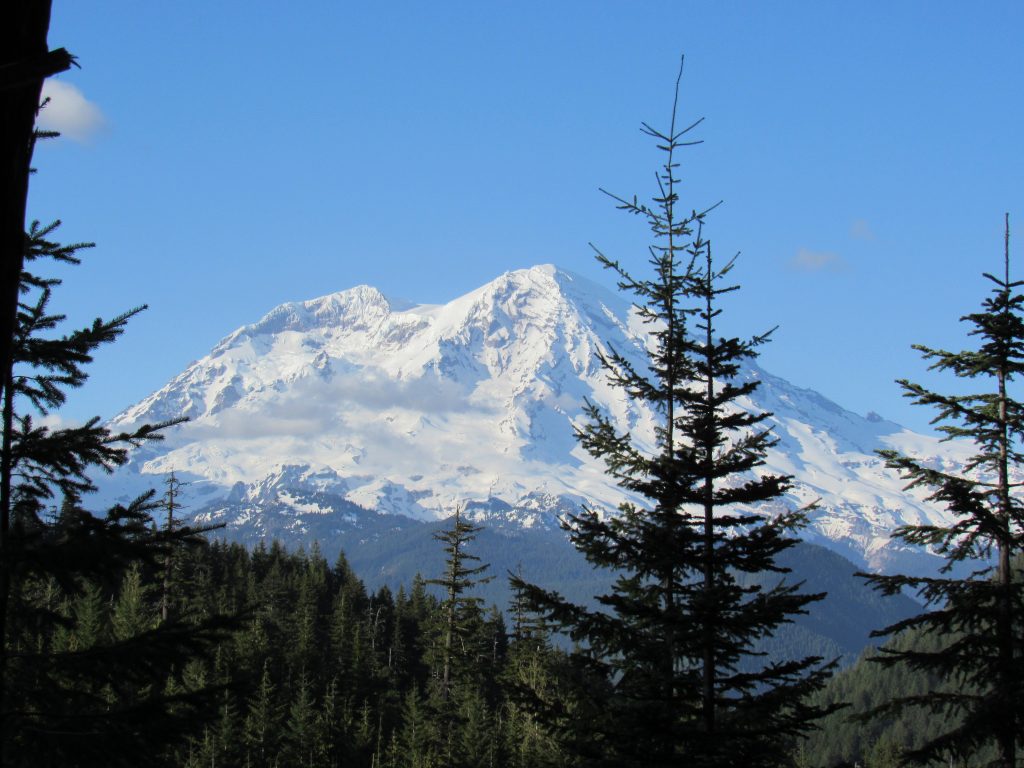National Park Service enacts reservation system for visitors of Mount Rainier
With an unusually hot forecast ahead for the summer, Washingtonians are booking trips to the mountains, while climate scientists continue to monitor the ecosystems of national parks.
Just south of Eatonville, Washington, you will find meltwater from the Nisqually Glacier which has been held back by the Alder Dam reservoir since 1945. Continue driving along Highway 7 past Alder Lake and cross over the Elbe train tracks that run into Ashford, where you will begin to see glimpses of a rocky, snow-covered mountain that stands at 14,410 feet in total elevation, nearly half the height of Mt. Everest.
Mount Tahoma, more commonly known as Mount Rainier, has 29 glaciers that are melting in an-ever changing climate. The Stevens Glacier has completely receded, now showing no signs of glacial movement, with nothing but a snowfield left to see, according to a report by the U.S. Department of the Interior National Park Service (NPS).
Big changes have come to Mount Rainier National Park—changes that aren’t just melting glaciers, changing geography and ecosystems.
The park service announced this year that park visitors will be required to make online reservations, noting high volumes of tourists as the primary reason to enact this change. Mount Rainier experiences up to 2 million visitors per year, occasionally overflowing the parking lots during the busiest months of July and August, at the height of wildflower season.
This change will affect all visitors to the Sunrise or Paradise corridors, with a pilot timed entry reservation system that aims to reduce congestion and the impact of overcrowding on trails by limiting the number of people coming into the park per day from 7 a.m. to 3 p.m., according to NPS.
The NPS states that the timed entry reservations are required as of May 24 through Sept. 2 for the Paradise Corridor and July 4 through Sept. 2 for the Sunrise Corridor. Visitors with wilderness permits or special use permits can use their permits in place of a reservation, depending on the corridor the permit applies to.
Those who have made reservations at the National Park Inn in Longmire, the Paradise Inn, or Cougar Rock campground are allowed to show proof of these reservations to gain entry through the gate after 1 p.m. on the day of the reservation. In addition, those with a camping permit for White River Campground can gain entry within the Sunrise Corridor without using the reservation system.

Each corridor will require a separate vehicle registration. The reservations are only good for one day, in addition to the already required entrance fee, “America the Beautiful” pass or other park pass for admission through the gates. However, if you enter the park by vehicle before 7 a.m. or after 3 p.m., you will be exempt from the rule, which was implemented in response to the large influx of tourists.
The main cause of climate change is human activity, especially through the release of carbon dioxide and other greenhouse gases into the atmosphere, aside from volcanic eruptions and changes in the sun’s energy, according to the U.S. Environmental Protection Agency.
Aside from the new reservation system which aims to limit human and vehicle traffic on trails and roads, in a 2023 Natural Resource Report, the U.S. Department of the Interior’s National Resource Stewardship and Science Directorate reported that heavy precipitation and warm surface temperatures for extended periods are melting the park’s glaciers at an average annual rate of –0.043 kilometers squared during a 125-year period.
As a result of climate change, the total glacial loss on Mount Rainier has amounted to 41.6%. The Paradise Ice Caves from the 1950s melted away completely in the 1980s, and the Pyramid and Van Trump glaciers have lost 32.9% and 33.6% of their area between 2015 to 2021. The Nisqually, Kautz, South Tahoma, Van Trump and Winthrop Glaciers have all released floods due to loose sediment, rainfall and extended periods of high surface temperatures, according to NPS.
Even the wildflowers are changing, with some species blooming earlier in the year due to the warming climate. The region’s natural beauty remains, with billowing clouds resting in the mountain’s nooks, bringing an average annual precipitation of 100 inches to Paradise Park, often resulting in high levels of snowmelt.
Paradise Park held a maximum snowfall record of 1,122 inches (93.5 feet) during the winter of 1971, setting a world record at the time as the snowiest place in the United States until Mount Baker broke the record in 1998 with 95 feet. On average, Paradise Park sees approximately 50 feet of snowfall, varying from 15 to 25 feet per year, with most of the snow sticking to higher elevations, according to NPS.
Reservations for corridor tickets can be made in advance at Recreation.gov, which shows a limited number of time slots available per day. If you hike far enough up the trails, you just might be able to experience a winter wonderland in the summer, near the glacial lakes.
Featured image caption: The view of Mount Rainier on a mountain trail in the Gifford Pinchot National Forest. Photo by Elissa Blankenship.



